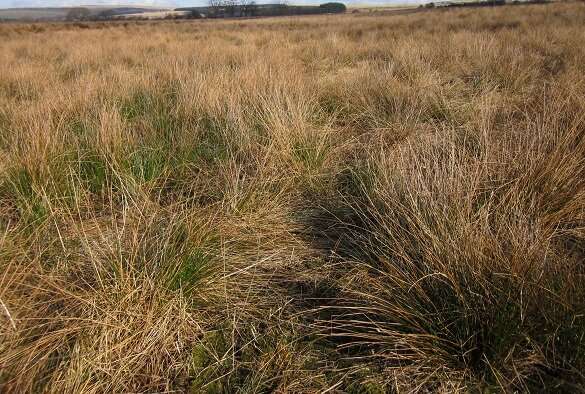Invasive rushes spreading in upland farm fields

A new study involving University of Liverpool ecologists shows invasive native species of rushes are spreading across UK upland farms and have the potential to threaten wildlife and the livelihoods of farmers.
Researchers used a series of Google Earth images to plot the spread of rushes in farm fields in the West Pennine Moor SSSI—an area of the Lancashire uplands between Bolton, Bury and Darwen.
The study is the first to investigate the spread of rushes in areas of the UK uplands. Although the study focused on one area of upland, anecdotal evidence suggests the problem could be happening across many other UK hill farms.
Using more than 200 images from Google Earth taken across a 13-year period between 2005 and 2018, the researchers found that rushes have spread across the surveyed area by between 82 percent and 174 percent.
Rushes, which are much taller than typical pasture grasses and tend to grow in tussocks, can be identified on color aerial photography, such as Google Earth images, because of their different color and growth form to surrounding grasses.
The spread of rushes in upland farmland is of growing importance because it has the potential to reduce the productivity of land for farmers—as livestock, like sheep, find it unpalatable.
Its spread is also problematic for wildlife as many wading birds, such as lapwing and redshank, do not like to breed in fields dominated by rushes.
The researchers also suspect that rushes, as a combustible material, could potentially increase the risk of moorland wildfires.
Dr. Mark Ashby, of Lancaster University and lead author of the study, said: "Our study corroborates the anecdotal reports suggesting that populations of tussock-forming rushes, such as soft rush, hard rush, and compact rush, have been increasing within upland grasslands.
"As they replace palatable grasses, rushes reduce grassland productivity. This can cause considerable losses to upland farm incomes on land where, owing to poorer soils and climate, it is already difficult to make a living. From a wildlife perspective, important upland birds, such as redshank and lapwing, choose not to breed in fields dominated by rushes."
Professor Rob Marrs from the University of Liverpool's School of Environmental Sciences provided his forty-year experience of weed control in the uplands and the interpretation of aerial photography to guide this study.
He said: "We all suspected that that soft rushes were increasing and reducing available grazing land (ask any upland farmer) but we had no idea about how big a problem it had become. The next phase of this work should be do similar studies in other areas to get a national perspective, but there is also a need for experimental work to derive sensible, cost-effective weed control strategies."
Rushes, which are native to the UK, are spreading perennials that prefer wet, acidic and nutrient-poor environments. They can vigorously reproduce, with each stand producing millions of seeds and seeds can remain dormant in the soil for up to 60 years.
It is not known why rushes are spreading. Researchers think it could be due to a number of possibilities, including:
- Inadequate field drainage and localized soil compaction.
- Changes in farming practices over recent decades such as reductions in the numbers of people working the land, heavier farm machinery and changes in livestock types and densities.
- Climatic reasons such as increasingly wet summers and winters and fewer frosts than in previous decades.
Dr. Mark Ashby added: "Determining the drivers of upland grassland rush expansion will help us understand how it can be halted or, in some cases, reversed, which would be of great benefit to hill farmers and upland biodiversity."
As the most effective way of controlling rushes is not known, the researchers believe more research is needed to find out more about the reasons why they are spreading across our uplands so a way can be found to bring them under control.
The study is outlined in the paper "Quantifying the recent expansion of native invasive rush species in a UK upland environment," which has been published by the journal Annals of Applied Biology.
More information: Mark A. Ashby et al. Quantifying the recent expansion of native invasive rush species in a UK upland environment, Annals of Applied Biology (2020). DOI: 10.1111/aab.12602
Provided by University of Liverpool



















